Is the US economy leading to recession? A recession occurs when the GDP of an economy contracts for two consecutive quarters. recently SBI Research Report It is said that long -term US GDP growth reflects a decreasing trend.
Concerns about the US post Trump’s tariff measures and expenses and the economic approach to job cuts have increased. Economists see Trump’s trade conflict as a possible threat to the American economy, with the possible consequences of increased consumer costs, reduced economic growth and reduced employment opportunities.
SBI said in its latest report, “The trends indicate that the US economy jumping into the post covid has been additionally known.
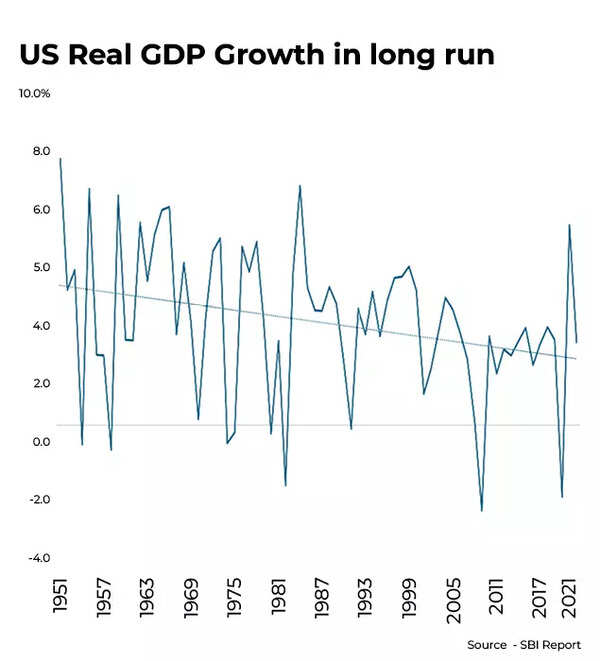
Long time US real GDP growth
The report also states that, “The enthusiasm of departments like Dogi can undo a lot of ground functions done in the last decades, which puts pressure on the economy downwards.” The DOGE or the Department of Government Efficiency is an initiative by US President Donald Trump and is led by Tesla’s CEO and Trump Advisor Elon Musk.
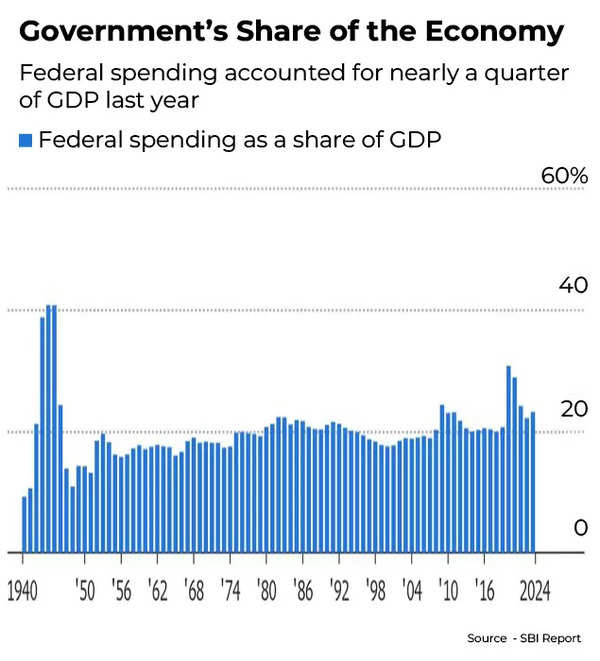
SBI report states that a lot of deduction in federal expenses can be disastrous
Economic uncertainty is large, especially notable it follows a period when the American economy demonstrated notable strength, managing the Kovid epidemic crisis. So is the US economy leading to the recession? We take a look at some important data pointers in SBI report and the expected trends in the US economy based on long -term history:
What US Economic Data is indicating
1) GDP growth trajectory: The SBI report stated that the analysis of US GDP development reveals a bottom of the projection, especially since 2000. The US economic indicators suggest a decrease in potential GDP, as well as with weak demand and investment patterns.
The SBI report said that the US economy has become weak in the last one year, GDP growth has come down from 3.2% to 2.5% in Q4 2023.
The report stated, “GDP now model estimates from Atlanta Fed for real GDP growth (seasonal rate, running estimates) in the first quarter of 2025 now -2.4% on March 06, below +2.9% on 31% (earlier estimates),” reports.
2) Loans: Rising national debt levels have become rapidly important, resulting in reduced private sector participation. The current trade policies associated with tariffs are expected to create immediate challenges without adequate improvement in GDP performance.
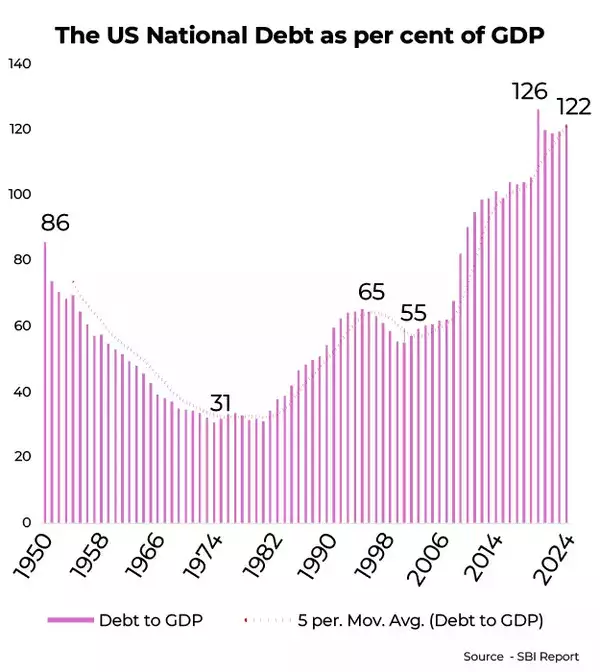
The loan for the GDP ratio reflects a secular growing trend, says SBI.
3) Low export, consumption: Post-Covid US economic growth seems extraordinary, responsible for comprehensive policy measures. Extended analysis suggests that a potential decline in US economic growth, with low exports and consumption.
4) Savings for GDP ratio: The total causative productivity growth is decreasing, while the value addition refers to negative progression. The level of high wages can prevent future investments. The savings-to-GDP ratio has reached its lowest point since 2011, marking the second lowest figure since 1951.
January saw the first decline in consumer spending in about 24 months, while the goods reached unprecedented levels due to expedited businesses to avoid the trading deficit implications, suggested possible economic contractions in the trimester. Consumer expenditure trends are expected to weaken in correlation with the approximate overall GDP recession.
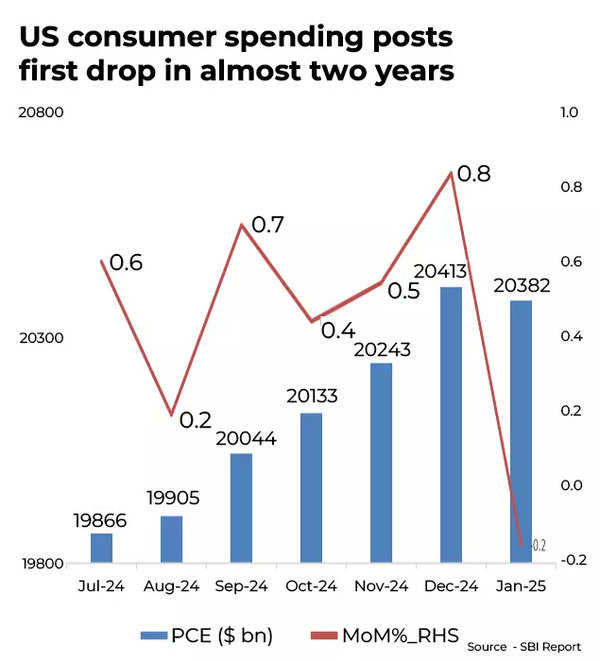
American consumer expenditure
5) Stock market havoc: S&P 500 has abandoned its November election advantage, with the Kovid -19 period with March 2025 to record the poorest monthly performance.
The US markets including S&P, with the market capitalization of around 52.9 trillions (February 2025), have reached their limits after giving extraordinary returns. Investors are forecasting income amidst continuous instability. The SBI report stated that the major ‘brilliant 7’ shows the vulnerability after the stock deep seik event, with traditionally stable companies such as Apple, such as Apple, stable companies face investigating their safe heaven status.
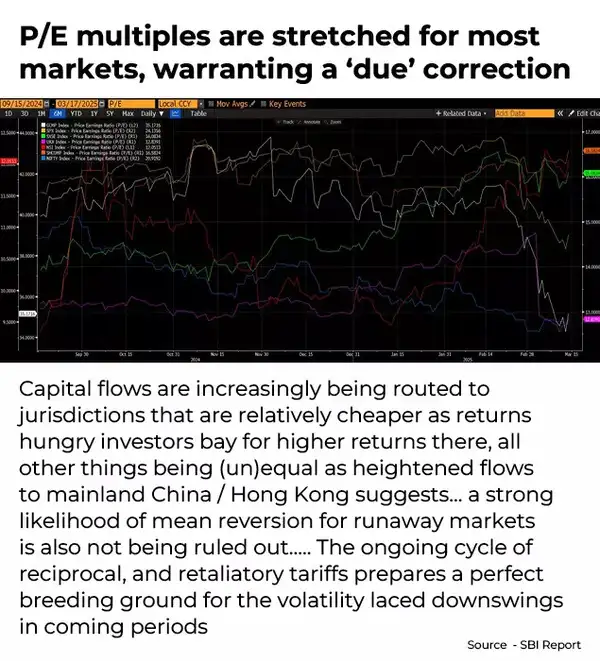
P/e qualities are spread to most markets
Investment flows are moving towards more affordable markets as investors seek clear returns from increased activity in the mainland China and Hong Kong markets. Analysts estimate possible reforms in overwalld markets. The ongoing range of mutual tariffs creates conditions to increase market instability in the upcoming period.
American Economy: What is a long -term approach?
SBI report states that positive structural adjustments may potentially increase GDP trends. Despite improving minor productivity, increased national savings can increase potential GDP. Re -involvement of the joint private sector with technological progress can promote the possibilities of development, although the initial adaptation period can present challenges. SBI report notes the following:
- American economy in GDP indicates long -term trends potential GDP, demand and fall in investment
- America’s debtor has increased rapidly, excluding the private sector
- However, high debt has not been reflected in US dollars, showing that cyclic trends have declined in its strength over the years.
- Current tariff policy will have short -term pain and US GDP will not see acceleration in physical way
- The US Dogi’s economic rational is clear from long -term trends
- If the structural adjustment receives traction, the potential GDP trend can see a change on one upward. Despite the nominal improvement in productivity, the major national savings coming from exercise can still increase potential GDP. With technological progress, the possibilities of increasing private sector congestion can significantly increase. However, there will be a short -term cost of this adjustment.


